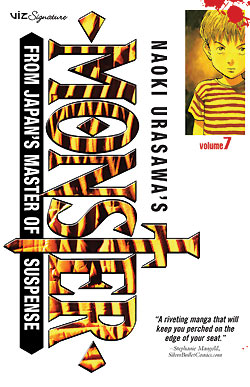
I was at Book Expo Canada a few weeks back and I intimated to a colleague that, for the first time in years, I couldn’t really “see” the shape of the manga market anymore. I had a pretty good handle on it up until the Kodansha rumours and Tokyopop flailing kicked in, but with companies leaving the market, with the Borders bankruptcy, with big reshuffles, with the Viz original content program, I guess I just lost track of it all. So I’m going to take 30 minutes and try and talk my way through it here… I’ve got until 1:00pm EST to finish this blog post. Let’s see what happens.
I guess first and foremost, the thing that bothers me about the Borders bankruptcy is that I honestly can’t believe how insular the book market is. It’s been rumoured for a number of years that if Borders, particularly when Kurt Hassler was the graphic novel buyer, didn’t want a book then the book didn’t get licensed (let alone published). At least so far as manga went, anyway. So when Borders dumped a ton of returns on pubs a few months ago and cut way, way back on their buying (to say nothing of the generally stingy purchasing habits of Hasslers’ replacements at Borders before the bankruptcy worries surfaced) suddenly titles, whole publishing lines, became unviable. Isn’t that nuts? There are still independent bookstores, another chain, and the rest of North America, but so much of the manga business was consolidated with one retailer (and one buyer) that these changes sent a major ripple throughout the industry.
 If I were a publisher, I’d be looking at my options. I’ve thought for a while that the graphic novel market in general, and manga in particular, has outgrown the “graphic novel section” of the bookstore. While about 80% of the manga being published could go to the same audience of 13-18 year olds (and those who read books for 13-18 year olds) there are a good number of books–and customers–who are likely tired of stepping over teenagers sprawled on the floor in the manga section. I think publishers working to develop newer and more diverse sections in bookstores is more important than ever, and there’s already been some headway made in developing separately stocked–and separately purchased–graphic novel sections in the children’s areas. Walk into most chain bookstores and you’re much more likely to find Pokemon: Diamond and Pearl Adventures Volume 1 across the aisle from the picture books rather than next to Naruto (although in an ideal world it might be cross-racked). Now, and here’s the trick, we need a grown-up graphic novel section, not only for the excellent (and future) D+Q, Picturebox, and Last Gasp offerings but so that the only difference between Battle Royale and Boys over Flowers isn’t some easily removed shrink-wrap. The industry is getting younger–the buzz words at the New York Comic Con were COMICS and FOR and KIDS–but it’s also getting older too, and older customers would like a different shopping experience than trying to find the latest Tatsumi or Inoue manga jammed in-between Ultimate Spider-Man and Naruto whilst simultaneously trying to avoid the outstretched gangly limbs of sullen teens thoroughly immersed in the Universe of the Four Gods.
If I were a publisher, I’d be looking at my options. I’ve thought for a while that the graphic novel market in general, and manga in particular, has outgrown the “graphic novel section” of the bookstore. While about 80% of the manga being published could go to the same audience of 13-18 year olds (and those who read books for 13-18 year olds) there are a good number of books–and customers–who are likely tired of stepping over teenagers sprawled on the floor in the manga section. I think publishers working to develop newer and more diverse sections in bookstores is more important than ever, and there’s already been some headway made in developing separately stocked–and separately purchased–graphic novel sections in the children’s areas. Walk into most chain bookstores and you’re much more likely to find Pokemon: Diamond and Pearl Adventures Volume 1 across the aisle from the picture books rather than next to Naruto (although in an ideal world it might be cross-racked). Now, and here’s the trick, we need a grown-up graphic novel section, not only for the excellent (and future) D+Q, Picturebox, and Last Gasp offerings but so that the only difference between Battle Royale and Boys over Flowers isn’t some easily removed shrink-wrap. The industry is getting younger–the buzz words at the New York Comic Con were COMICS and FOR and KIDS–but it’s also getting older too, and older customers would like a different shopping experience than trying to find the latest Tatsumi or Inoue manga jammed in-between Ultimate Spider-Man and Naruto whilst simultaneously trying to avoid the outstretched gangly limbs of sullen teens thoroughly immersed in the Universe of the Four Gods.
It’s a little bit like why I think the pleas for more josei and more seinen are misguided; there’s no market for these books. There isn’t even an effective delivery system for them, they aren’t even designed for their target audience. The audience for the books isn’t going to find them in the manga section, and the books don’t look like something that they’d like in the first place because they adhere so strongly to manga packaging conventions (likely in a bid to capture the existing market) that even if you put a josei title next to the women’s fiction (read: chick lit) most women would look at it like some child/freak/pervert dropped it on the wrong table. Sure, you can do your buying online, but then you’re not a casual buyer, you’re not growing the audience, you’re selling to the initiated. That’s the situation we have right now, and that’s why there are so few books. Things are changing… I think Viz’s Seinen manga line is going to be interesting, I think Aurora has a lot of potential, but right now there’s almost no difference in the look or packaging of kids, teen, and adult manga, and if that isn’t crippling potential sales I don’t know what is.
Well, it’s 1pm. Time for me to get back to work. This is one of those posts that friends in the industry admonish me about, that I’m giving away secrets when I should be charging big bucks for this sort of advice. C’est la vie, sometimes you just gotta blog. But if you are a publisher who has found this useful then I demand free drinks in San Diego and to be put on your comp list. Send it care of The Beguiling.
I’ll be writing a part two at some point in the next day or two.
– Christopher


Nicely said and timely as always, Christopher. Looking forward to part two.
Viz’s Seinen line — this is new information, isn’t it? Don’t suppose there’s anything out there about what titles are in it?
James-
At that point I’m referencing Viz Signature, which I suppose isn’t necessarily a Seinen line, but between “Monster” and the Umezu and “Solanin” and “Vagabond” and “REAL”, it’s pretty close?
I wish they’d give it a name other than “viz signature”
Also, Monster’s almost over, so 20th century boys should start coming out. hurray
And I haven’t heard of Solanin, what’s it about?
What I see is the manga business is turning quickly into the comic business – there’s the big 2 (Viz and Kodansha as to Marvel and DC) where they publish titles everyone wanna buy and carry. Comon! With the 3 biggest publishers exclusive with these 2 publishers, what is really left out there for others (UDON among them) to license? Then, all of us smaller guys are gonna be struggling to fill the little shelf space left, if any. This is exactly what we are experiencing in the Comic market and I can totally see the manga shelves going that route. Worse is, the mass market buyers are not as sentimental on carrying titles. They will drop a title even faster if it does not sell. I can see a lot of publishers go and fight for whatever is left out there whether the book is good or not just to expand their presence. But by the end, it is the same mentality that kills them, as well as it is the downfall of the whole business.
Is Manga just a hype as some says? I do not think so. The question now is how do we make this form of entertainment, this category of reading materials last in the market.
Back to you Chris….
In Borders here in New Zealand, I could only name Monster, Wild Adapter, Welcome to the HK and the Chuangyi editions of Vagabond from Singapore as anything remoting resembling “adult” manga at all.There is certainly nothing in shrink wrap (that I noticed). Borders is very definitely aimed at the teen market.
Viz manga was apparently for some time not able to be imported by anyone, owing to the North American only licensing issue, altough seems to have been resolved/ignored.
Fortunately in Wellington at least we have a specialist manga/pop culture store. So between them and Borders it appears to have destroyed any chance of our local direct market comic-book store making money from manga.
Sorry, got the wrong end of the stick. Never mind.
Erik- I think it’s difficult for smaller publishers because you either try and license stuff that’s similar to what’s already selling and compete head to head with the “top publishers”, or try to do something new and risk not getting ordered at all because you’re not publishing “what’s selling”. I posted part two of this, and I pointed out that the Yaoi publishers seem to have carved out a niche for themselves and are doing reasonably well within it. Perhaps that’s a model to follow, license works that aren’t going to sell to the Tsubasa/Naruto/Fullmetal Alchemist crowd, and go from there. I think you guys are on a good track with ROBOT, for example, and are the only guys publishing oversized, full colour manga for a mature audience. If you could develop and expand that base, you could end up being the market leaders there…
Besides, I think that as easy as it is to say that it’s Viz versus Del Rey, that ignores Kodansha’s own publishing efforts coming soon, not to mention the ridiculously well-invested Yen Press, and Tokyopop isn’t down for the count yet.
It’s still a developing field, in my opinion.
John- I’m sorry to hear that. I don’t know what the market is really like in New Zealand so I can’t comment. I do know that here in Canada despite some of those factors, we’ve been able to make a decent go of the manga business as a direct market comic book store…!
My (former) store, the massive Barnes & Noble located near Lincoln Center in NYC, has four bays of manga, one bay of generic graphic graphic novels, and a bay and a half (two if you count the display fixtures) of Marvel and DC.
Looking at the American bookstore market, DC and Marvel do not dominate the shelves as much as in the Direct Market. My bestseller last year was Pokemon Red and Yellow. Followed by Persepolis, 300, Watchmen, American Born Chinese, and Bone.
Even in the Direct Market, there are many other publishers offering interesting and profitable lines of graphic novels. Manga publishers can use similar business strategies to succeed. Find a niche, exploit it, build a reputation.